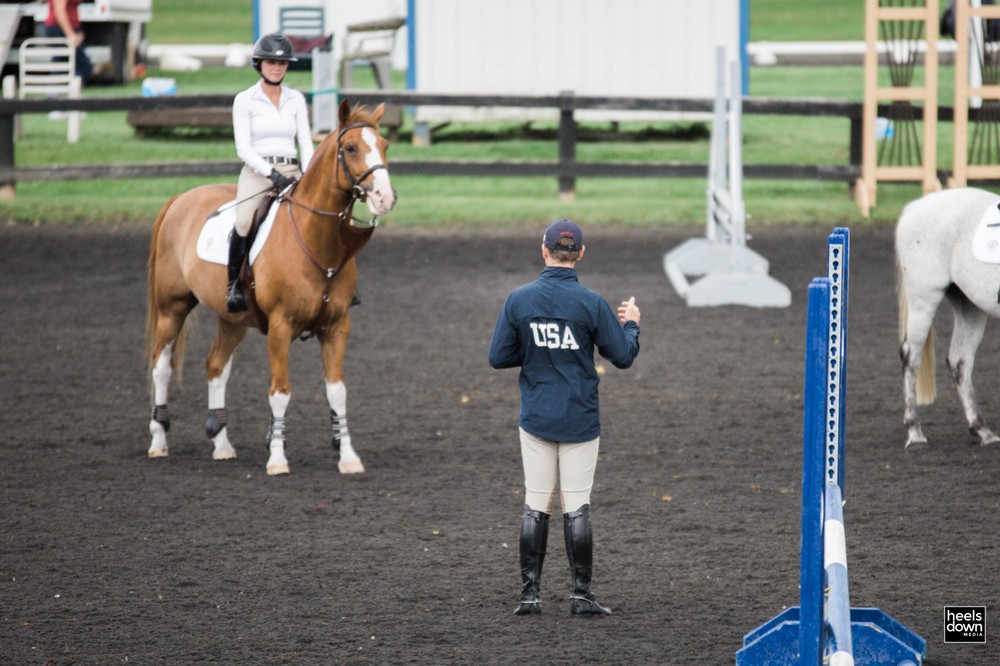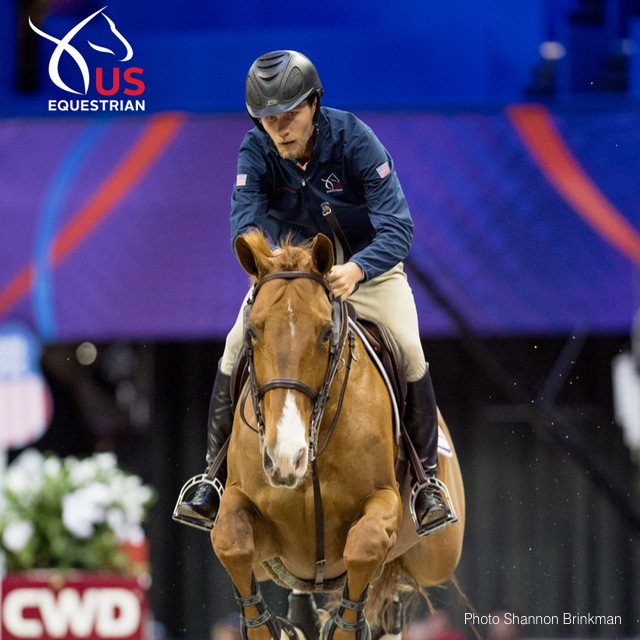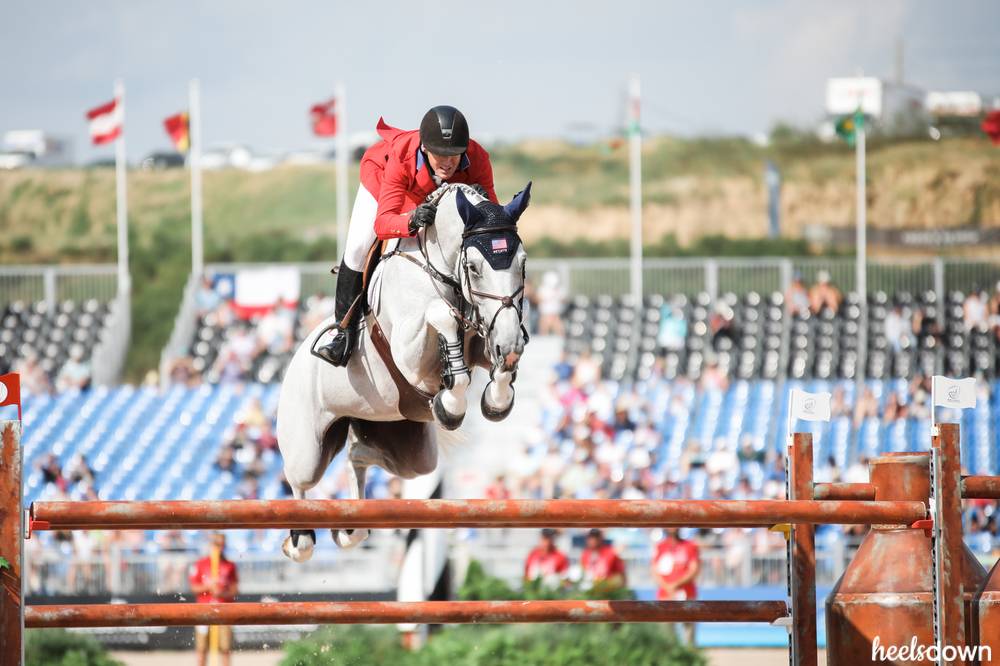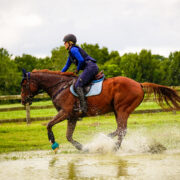Reiterating the Value of the “Perfect Position”

I think by now, most, if not all, of the equestrian community has seen Karl Cook’s interview in Nöelle Fllyod on “dispelling the myth of ‘the perfect position’” and McLain Ward’s and John Madden’s Facebook responses to it. I don’t want to stir the gossip pot, instead I want to focus on the subject: position.
Now, compared to these equestrians, I am just a lowly professional, I have never competed (and will never compete) in Grand Prixs and I definitely do not train horses and riders to compete at such a high level of our sport. However, in my role in the industry, I have some strong feelings on the importance of position and I want to offer up some thoughts from a professional much lower on the equestrian industry totem pole.
As a trainer whose background is in starting horses under saddle, position is an immeasurable tool. Whenever we interact with horses, our position and body language matters because it’s our most effective way of communicating with horses in a way they communicate with each other and understand. This is something that is helpful not only when starting horses in the round pen. It’s helpful when catching loose horses at a show, when trying to shoo a horse away from something dangerous, and in giving a nervous horse a sense of security. If the positions of our bodies matter so much on the ground, why wouldn’t it matter in the saddle?
I agree with Cook on some small points. I agree that “good position is one that moves fluidly with your horse” and should not be based in stiffness. However, the biggest statement that stood out to me in his interview was the comment that “Function doesn’t follow form; form follows function.” I couldn’t disagree with this statement more. Form doesn’t follow function; form creates the ability to function correctly. Without proper form, it is impossible to be in the correct position; and without being in the correct position it is impossible to be effective in staying out of our horse’s way, so that they can perform to the best of their ability.
John Madden said it best in his rebuttal to Cook: “Correct position minimizes mistakes. It keeps the rider from falling back and catching the horse in the mouth or crushing the horse’s back or keeps a leg from inadvertently abusing the horse’s side. In the best-case scenario, it gives the horse the ability to jump its best without impingement from the rider. In the worst-case scenario, it puts the rider in a place to be most effective when something goes wrong.”

It is true that (like many professionals) a part of my income comes from teaching lessons that involve the riders’ positions, but it isn’t my income that I worry about with Cook’s remarks, I worry about safety for both horse and rider. In the same way our body language and position matters on the ground, our position in the saddle matters no matter what saddle we are sitting in. The principle of the ideal position is the same no matter the discipline: to stay out of the way for the horse. Yes, stirrups might be longer in western and dressage than in the hunter/jumper world, but our point of balance in our seat is the same. And a jockey racing galloping a horse towards the finish and a reiner saying “whoa” as their horse slides into the dirt will both have their heels down even though they are asking their horses to accomplish very different things. These similarities in positions across disciplines are important because position is at the root of effectiveness and safety of both horse and rider.
It is our responsibility to make sure our position is correct so we are not putting ourselves or our horses at risk of injury. Like Madden noted: “So much of what we do in our sport and with horses is out of our control. One’s position is something we CAN control.”
Let’s be real here: correct position isn’t easy. It takes patience, practice, and fitness. At 5’2” on a good day and always a little chubby, my equitation and position is something I worked really hard at throughout my junior years without much reward. I used to think that it was simply because I didn’t look the part, and it wasn’t until I started riding in IEA and IHSA that my equitation and being able to be effective on unknown mounts was rewarded. Because of the frustration I had as a child struggling to deal with show placings that never seemed to match the work I was putting in; I worry about Cook’s comments that seem to dismiss the importance of equitation. As a junior rider, I was extremely lucky to have a coach who was constructive with her criticism, but always knew when I needed some positive words to keep striving for perfect position.

I worry with Cook’s comments that younger riders will also dismiss the importance of position when they are not seeing those blue ribbons. I agree with Ward completely: “Classical position and balance on the horse should always be taught and is something every rider should strive for to reach their potential and to allow their horse to be their best.”
I hope that Cook’s intentions were not to completely reject the importance of equitation. In my opinion, what Cook needs to do is acknowledge his position in the equestrian community. As an equestrian who has competed at the top of our sport in the Olympics, his words mean something to the younger generations. He needs to make sure he acts in the best interest of the horses and equestrians currently working their way up the ranks and those who have just started.
Like Ward said in his “edit” to his Facebook post: “I have great passion for what I do, I have strived to live up to the principles of our profession and have a great respect for those who have come before me and have shared their education and experience with us. I think it is very important we don’t lose respect for any of those ideals.”
Equitation and striving for perfection in position isn’t something that is outdated or unnecessary. Equitation was created with a purpose, to allow horse and rider to be the best team that they can be. In short, there is an ideal position and there are lots of reasons why we work so hard to reach perfection. Our horses deserve riders who are always diligent about creating and maintaining the position that makes the partnership safe and clear communication.


